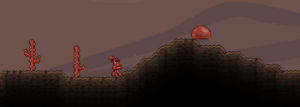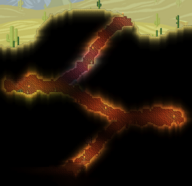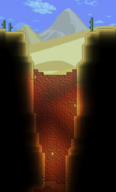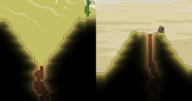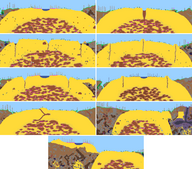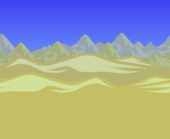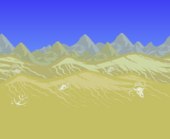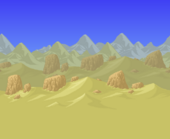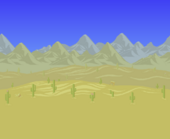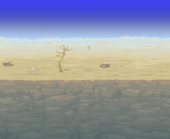Desert
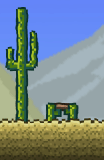
The Desert is a biome which consists predominantly of Sand Blocks and cacti. Every world contains a main Desert area (which houses the Underground Desert(Desktop, Console and Mobile versions) biome beneath it) and, possibly, additional small Desert patches called Dunes (which only contain layers of Sand Blocks on the surface and do not have underground parts). Pyramids and small pools of water can rarely appear in Dunes. On the ![]() Desktop version,
Desktop version, ![]() Console version, and
Console version, and ![]() Mobile version, objects in the Desert appear slightly hazy due to heat distortion, and water has a unique turquoise color. A Desert can also be generated with an Oasis(Desktop, Console and Mobile versions) mini-biome, featuring Palm trees and a large pool of water in the center.
Mobile version, objects in the Desert appear slightly hazy due to heat distortion, and water has a unique turquoise color. A Desert can also be generated with an Oasis(Desktop, Console and Mobile versions) mini-biome, featuring Palm trees and a large pool of water in the center.
An area is considered a Desert biome if there are at least (Desktop, Console and Mobile versions)1500 / (Old-gen console and 3DS versions)1000 Sand Blocks, Hardened Sand Blocks or Sandstone Blocks,[1] causing the water and background to change. Cacti and Desert enemies can spawn on even a single block of sand, however. Deserts are overridden by most other biomes, including the Ocean. Rain will occur in Deserts just as in any other surface biome. A Sandstorm(Desktop, Console and Mobile versions) may occur when wind speed is over 30 mph, which causes special enemies to spawn and pushes the player in the direction of the wind.
The Desert can be infected by the Corruption, the Crimson, or the Hallow. Corruption/Crimson Deserts may already spawn upon world creation. The enemies from the main biome (the evil biome or the Hallow) can spawn in an infected Desert alongside the normal Desert enemies (except for Mummies and Sand Sharks(Desktop, Console and Mobile versions), which have special biome-specific variants), and the music from the main biome is played. The sand in an infected Desert is replaced by Ebonsand, Crimsand, or Pearlsand Blocks, respectively. Although their color will change, cacti still drop Cactus when cut, and Waterleaf are also able to grow in a Hallowed Desert.
Contents
 Vulture
Vulture Antlion
Antlion Albino Antlion(Old-gen console and 3DS versions)
Albino Antlion(Old-gen console and 3DS versions)
 Mummy
Mummy Light Mummy(Hallowed)
Light Mummy(Hallowed) Dark Mummy(Corrupted, (Old-gen console and 3DS versions) Crimson)
Dark Mummy(Corrupted, (Old-gen console and 3DS versions) Crimson) Blood Mummy(Desktop, Console and Mobile versions)(Crimson)
Blood Mummy(Desktop, Console and Mobile versions)(Crimson) Shadow Mummy(Old-gen console and 3DS versions)(Corrupted)
Shadow Mummy(Old-gen console and 3DS versions)(Corrupted) Spectral Mummy(Old-gen console and 3DS versions)(Hallowed)
Spectral Mummy(Old-gen console and 3DS versions)(Hallowed)
 Desert Key(Desktop, Console and Mobile versions)(1/2500 (0.04%) chance)
Desert Key(Desktop, Console and Mobile versions)(1/2500 (0.04%) chance)
 Mummy set(rare)
Mummy set(rare)
 Fast Clock(rare)
Fast Clock(rare)
 Dark Shard
Dark Shard Megaphone(rare)
Megaphone(rare) Blindfold(rare)
Blindfold(rare)
 Light Shard
Light Shard Trifold Map(rare)
Trifold Map(rare)
 Banana Split(Desktop, Console and Mobile versions)(rare)
Banana Split(Desktop, Console and Mobile versions)(rare)
 Sand Block
Sand Block Ebonsand Block
Ebonsand Block Crimsand Block
Crimsand Block Pearlsand Block
Pearlsand Block Hardened Sand Block(Desktop, Console and Mobile versions)
Hardened Sand Block(Desktop, Console and Mobile versions) Hardened Ebonsand Block(Desktop, Console and Mobile versions)
Hardened Ebonsand Block(Desktop, Console and Mobile versions) Hardened Crimsand Block(Desktop, Console and Mobile versions)
Hardened Crimsand Block(Desktop, Console and Mobile versions) Hardened Pearlsand Block(Desktop, Console and Mobile versions)
Hardened Pearlsand Block(Desktop, Console and Mobile versions)
 Desert Pylon(Desktop, Console and Mobile versions)
Desert Pylon(Desktop, Console and Mobile versions)
 Desert
Desert Desert (Otherworldly)(Desktop, Console and Mobile versions)
Desert (Otherworldly)(Desktop, Console and Mobile versions)
Entrances to the Underground Desert
There is a 1/2 (50%) chance that the main Desert will generate with one of four types of structures that lead towards the Underground Desert. These are called chambers, pit, anthill, and larva hole.[2]
- The chambers consist of of a zigzagging downward tunnel with one or two small rooms connected to the corners.[3]
- Pits are large funnels generated at the center of the Desert.[4]
- Anthills are upward cones with narrow downward holes in the center. 2–3 anthills will generate across the surface of the main Desert.[5]
- Larva holes are downward funnels with narrow holes in the center. 2–3 larva holes will generate across the surface of the main Desert.[6]
NPC happiness (Desktop, Console and Mobile versions)
| Loved by | n/a |
|---|---|
| Liked by |
|
| Disliked by | |
| Hated by |
For more information, see NPC happiness.
Notes
- In Celebrationmk10 and Get fixed boi worlds, a Pyramid is always generated at the center of the main Desert, replacing the original entrance to the Underground Desert.
Trivia
- (Desktop, Console and Mobile versions) The Desert is the least popular biome for housing (discounting invalid housing biomes like the Corruption and the Crimson). A total of five NPCs either hate or dislike living in it, more than any other biome.
- The Desert and the Glowing Mushroom biome are the only surface biomes without a biome-exclusive boss.
- (Old-gen console and 3DS versions) The Desert is the only biome not to contain any special fishing catches.
- According to the Bestiary(Desktop, Console and Mobile versions) entry for the Sand Shark(Desktop, Console and Mobile versions), a saltwater river ran through the Desert in ancient times.
Gallery
Backgrounds
This content is transcluded from Biome backgrounds § Desert.
History
- Desktop 1.4.0.1:
- Added three new backgrounds.
- Added Otherworldly Desert track.
- Added Blood Mummy.
- Oasis biome now generates in deserts.
- Added Vulture as the ambience in the Desert background.
- Now generate less commonly and larger with more natural dunes.
- Banana Split now drops from Antlions, Antlion Chargers and Antlion Swarmers.
- Desert Pylon is now sold by any happy NPC's Shop.
- Coconuts and Bananas now drop from shaking Palm trees.
- Enemies now have chance to drop Desert Key.
- Desktop 1.3.3:
- Added Sandstorm event.
- Added a heat distortion visual effect.
- Desktop 1.3.0.1: Added Underground Desert, including new enemies and blocks.
- Desktop 1.2.3: Fixed a bug where Crimson Deserts were not making the water show up red.
- Desktop 1.2:
- Water in Deserts is now yellow.
- Now has its specific music.
- Desktop 1.1:
- Cacti no longer damage the player.
- Now has own specific background.
- Desktop 1.0.6:
- Cacti no longer cause knockback when damaging players and no longer destroy blocks above when growing.
- Deserts spawn slightly farther away from the initial spawn point.
- Desktop 1.0.5: Cactus, Waterleaf, Antlion, and Vulture added to Desert biomes.
- Desktop 1.0.2: Sand no longer spawns within a certain distance of the spawn location. This removes the chance of spawning in a Desert with no wood to use.
- Desktop-Release: Introduced.
- Console 1.4.0.5.4.1: Added all features and changes from Desktop 1.3.3 to 1.4.0.1.
- Console-Release: Introduced.
- Switch 1.4.0.5.5: Added all features and changes from Desktop 1.3.3 to 1.4.0.1.
- Switch 1.0.711.6: Introduced.
- Mobile 1.4.0.5.0: Added all features and changes from Desktop 1.3.3 to 1.4.0.1.
- Mobile-Release: Introduced.
- 3DS-Release: Introduced.
References
- ↑ Information taken from the
 Desktop 1.4.0.5 source code, method
Desktop 1.4.0.5 source code, method ExportTileCountsToMain()inTerraria.SceneMetrics.cs, propertyEnoughTilesForDesertinTerraria.SceneMetrics.cs, and fieldDesertTileThresholdinTerraria.SceneMetrics.cs. There may be inaccuracies, as the current Desktop version is 1.4.4.9.
Desktop version is 1.4.4.9.
- ↑ Information taken from the
 Desktop 1.4.0.5 source code, method
Desktop 1.4.0.5 source code, method Place()inTerraria.GameContent.Biomes.DesertBiome.cs. There may be inaccuracies, as the current Desktop version is 1.4.4.9.
Desktop version is 1.4.4.9.
- ↑ Information taken from the
 Desktop 1.4.0.5 source code, methods
Desktop 1.4.0.5 source code, methods Place()inTerraria.GameContent.Biomes.Desert.ChambersEntrance.csandPlaceAt()inTerraria.GameContent.Biomes.Desert.ChambersEntrance.cs. There may be inaccuracies, as the current Desktop version is 1.4.4.9.
Desktop version is 1.4.4.9.
- ↑ Information taken from the
 Desktop 1.4.0.5 source code, methods
Desktop 1.4.0.5 source code, methods Place()inTerraria.GameContent.Biomes.Desert.PitEntrance.csandPlaceAt()inTerraria.GameContent.Biomes.Desert.PitEntrance.cs. There may be inaccuracies, as the current Desktop version is 1.4.4.9.
Desktop version is 1.4.4.9.
- ↑ Information taken from the
 Desktop 1.4.0.5 source code, methods
Desktop 1.4.0.5 source code, methods Place()inTerraria.GameContent.Biomes.Desert.AnthillEntrance.csandPlaceAt()inTerraria.GameContent.Biomes.Desert.AnthillEntrance.cs. There may be inaccuracies, as the current Desktop version is 1.4.4.9.
Desktop version is 1.4.4.9.
- ↑ Information taken from the
 Desktop 1.4.0.5 source code, methods
Desktop 1.4.0.5 source code, methods Place()inTerraria.GameContent.Biomes.Desert.LarvaHoleEntrance.csandPlaceAt()inTerraria.GameContent.Biomes.Desert.LarvaHoleEntrance.cs. There may be inaccuracies, as the current Desktop version is 1.4.4.9.
Desktop version is 1.4.4.9.



